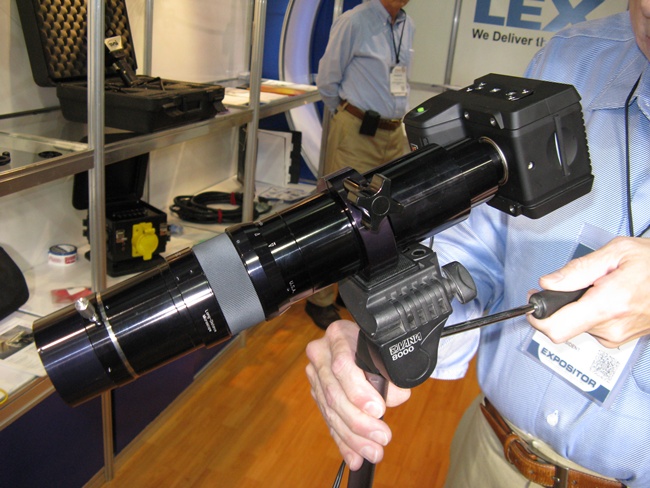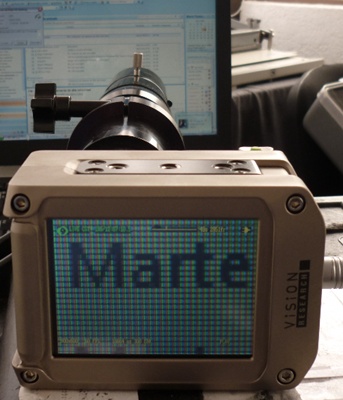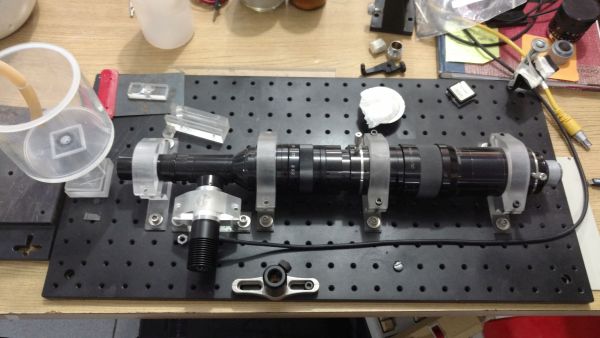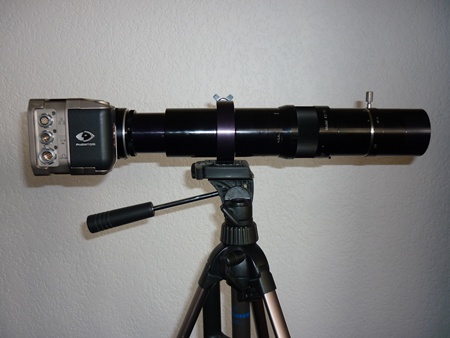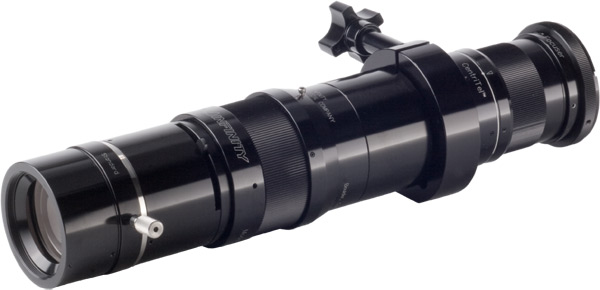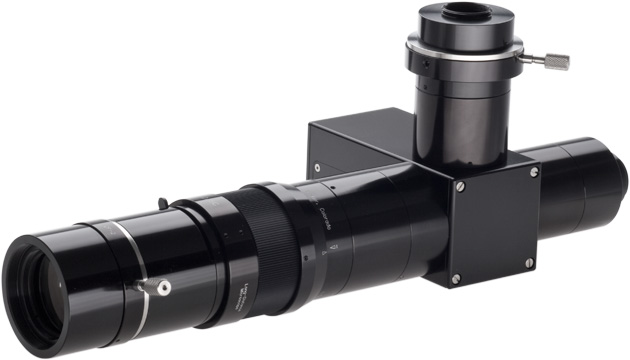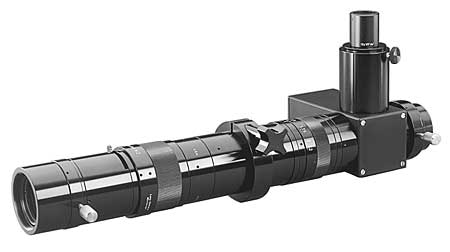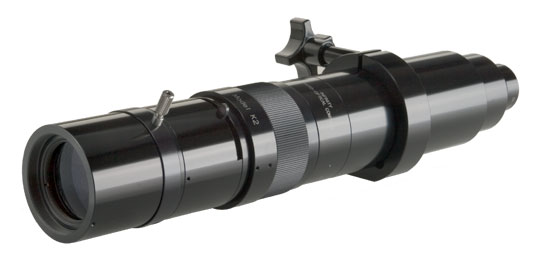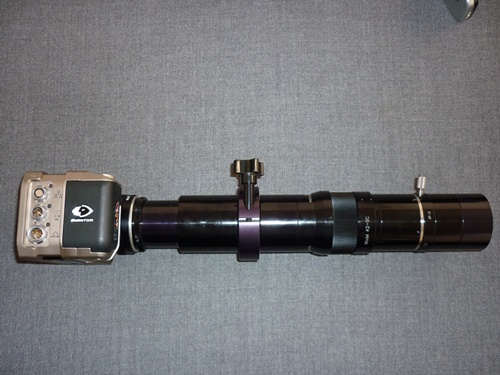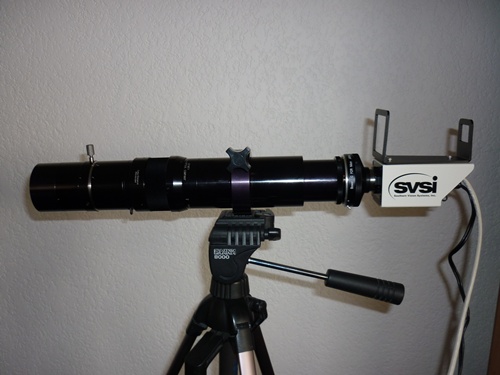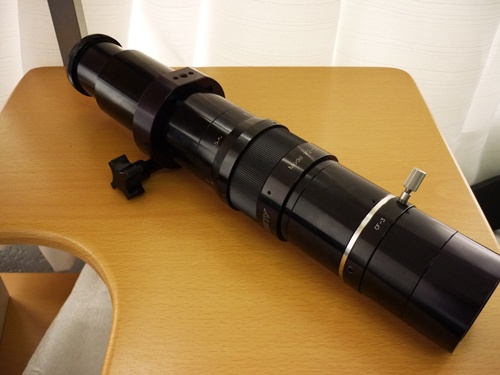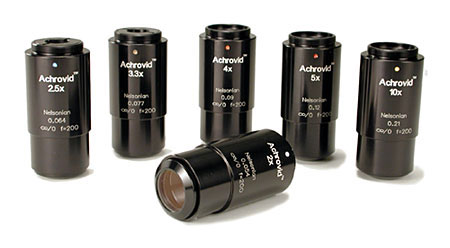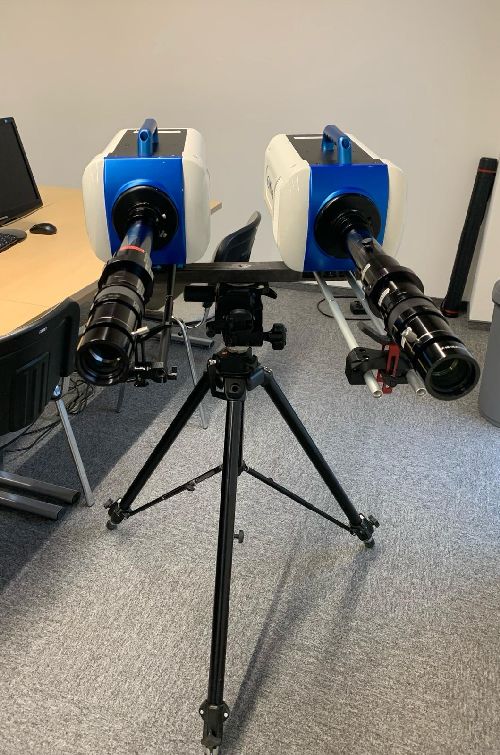- Model K2 DistaMax - Ready for the Digital Age
- Applications
- Three Operating Ranges
- Amplifiers
- CentriTel®

Model K2 DistaMax - Ready for the Digital Age
No other manufacturer's long-distance microscope provides operational ranges, potential resolving powers or format choices equal to Infinity's Model K2.
The K2 is an unobstructed refractor—just like laboratory microscopes. Unlike obstructed, inherently lower-contrast catadioptric mirror systems, it does not produce out-of-focus "doughnut" artifacts. As explained in a scientific paper which stands on its own merits, the previous generation Model K2 was chosen for its unique characteristics: http://www.tu-braunschweig.de/Medien-DB/ism/pchristian-kaehler.pdf . The present Model K2 achieves even greater performance levels.
Since its inception, the Model K2 has been the definitive world-standard state-of-the-art long-distance microscope, capable of resolution and magnification comparable to that of regular compound laboratory-type microscopes—but at many times greater working distances. Over time, the K2 evolved expanded capabilities such that it could image a "Blood Moon" down to a blood cell—even, if required, with a 1.4 NA oil-immersion microscope objective—in transmitted or coaxial illumination. Then, in 2008, Infinity announced that K2 Long-distance Microscopes could be supplemented with the CentriTel™ Focuser. For the first time, the K2 (by then, the K2/S) could translate focus from a fixed position—without essential magnification changes. This makes it ideal for 3D stacks and Z-depth measurements.
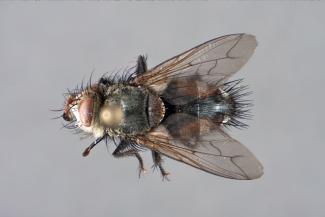
Applications
How GOOD is the K2? In Sum...
The K2 represents the ultimate in long-distance microscopy. No other instrument can do what it can do, and do it all so well. Contact us so that we can tell you how the Model K2 can solve your imaging problems.
New AVS-2 System
While the original K2 was designed with an AVS-1 system which functioned best for larger formats when amplified by a 2x factor, the new AVS-2 system in the K2 has twice its optical elements. Spherical and chromatic aberrations are now actively compensated with focus. In addition, the more complex AVS-2 system allows a 1.66x factor to fill formats as large as 35mm (24mm x 36mm; 43mm diagonal). By actually lowering the magnification—yet still providing full field coverage with modern large format sensors and DSLRs—the resolution can best match digital pixel sizes. As a result, images can be captured with greater light throughput. More importantly, they can be subsequently enlarged even more than before because details are more likely captured on individual pixels, not overly-projected onto several of them. Everyone has experienced this problem in day-to-day life. For example, the last time you were inside a microscope was the last time you were in a cinema. Microscopes function similarly, and the more projection distance or magnification, the duller and more dissipated the image becomes. It makes no sense to magnify so much, that the Airy discs (the "lithographic dots") of the image get spread out over too many pixels, degrading and fogging the image. Rather, magnification needs to be kept "tight" while the resolution of the system is maintained. That is why we developed AVS-2 for Model K2/SC.
Pixel-matched Performance
But AVS-2 itself is only part of the story. To take full advantage of AVS-2, a whole new range of universal format amplifiers had to be developed as well. Utilizing the S Lens technology from the previous K2/S model, a new version of the 2x TX Tube (this factor being optimal for longest working distances when the S Lens is in-system) functions as a supplemental amplifier when the K2 is used from infinity down to 675mm with the Standard Objective. Then, when the the S Lens is not in-system, the K2 can be used with Standard and CF-series Objectives from 980mm down to 55mm and with the InFocus™ Objective Holder and infinity-corrected microscope objectives—to the limits of optical microscopy. For use without S Lens in-system a new 1.66x amplifier—the CF Tube—was developed. With the Standard and CF-series Objectives which have 38mm apertures (CF-4 = 20mm), the 1.66x factor is the theoretic ideal. It fills sensors up to 35mm (24 x 36mm; 43mm horizontal) format from edge to edge. Then, when the CF Tube is used with the InFocus™ Objective Holder (itself having a 1.5x factor) the ideal 2.5x microscopical factor is achieved. In short, the K2 can match its performance to pixel sizes specific to whichever objectives are used with it.
Large Pixel-matching in High-Speed Applications
High-speed cameras generally need large pixels to achieve reasonable performance levels. To match pixels that are c.20-microns in size, a 3.33x magnification factor is preferred . The K2 can be amplified 3.33x onto such sensors by equipping it with the Unipar Camera Adapter and 10x Wide-field Eyepiece to enlarge the image by a precise 3.33x factor.
TR (2x doubler) Back by Popular Demand
While it is true that the best amplified K2/SC imagery is obtained by using the CF Tube (1.66x factor), some users have asked for the return of the traditional 2x factor TR Tube. Some real-time applications benefit from its additional magnification. Accordingly, we have reinstated the TR Tube for use with the Standard and CF-objectives (when the S Lens is not in-system. The TR Tube is positioned on the K2 by putting the T36 tube in front and the S58 Tube in back--then the appropriate camera mount. It can be used with all sensors up to and beyond the 35mm (24 x 36mm; 43mm diagonal) format.
Other Benefits
There is still another important benefit of the AVS-2 system. Just "filling" a 35mm format is not enough. The field must be "clean" (virtually diffraction-limited) to its edges. The AVS-2's sophisticated optical design assures that not only can the 35mm format be utilized, but properly to its edges. The result is that the 2x TX tube and 1.66x CF Tube are matched amplifiers to the AVS-2 system itself. The small 2x DL Tube (adding only 12mm to the total) also falls within the corrective characteristics of AVS-2; the 1-2.2x Zoom Module was equally computed to work in concert with AVS-2.
In addition to all Main Body features from the previous K2/S, the K2 incorporates a Focus Ring Lock. This serves two purposes: a) to lock the focus at any specific point (for example, when the CentriTel Supplemental Focuser is used) and; b) to reference a focus that has been established (for example, infinity when infinity-corrected microscope objectives are used).
As if that were not enough, the K2 is considerably lighter in weight than competitive instruments. This means that equivalent accuracy can be obtained from less-expensive positioners which do not have to bear such bulk or weight.
Two Main Body Configurations
In order to maximize the potentials of the K2/SC, care was taken to design matched amplifiers that account for the characteristics of the new AVS-2 internal focusing system (twice the lens elements of AVS-1). Two configurations are now possible which maximize imaging for different purposes.
1) S Lens in-system:
The K2 maintains the S Lens technology from the previous Model K2/S. This means that when the S Lens is positioned inside, the K2/SC can focus from infinity down to c.675mm when the Standard Objective is used exclusively with it. Amplifiers exclusively suited for use when the S Lens is in-system are the 2x TX Tube (all formats up to 35mm), 2x DL Tube (C-mount only), the 1-2.2x Zoom Module—as well as the UNIPAR/Eyepiece system.
2) Without S Lens in-system:
This is the most versatile K2/SC configuration. The S Lens is not utilized in the the Main Body. An additional T36mm is placed after the S58 Tube or Mirror Diverter ports. This balances the image quality in conjunction with the AVS-2 internal focusing system. Then, the T36 can be removed and a CF Tube 1.66x parfocal amplifier put in its place. This 1.66x factor (rather than 2x) still covers the 35mm format and, in conjunction with the AVS-2 system, provides image quality maintained even to the edges of the field. The resolution thus captured is actually able to be enlarged more than when a 2x amplifier is used, since the 1.66x factor matches the pixel sizes of large format sensors more properly. Then, when the InFocus™ Microscope Objective Holder is used, it combines to produce the theoretically most-proficient large format magnification factor of 2.5x times the objective's rated power. The full imaging quality is maintained in strict accordance with the most demanding microscopical practices. In this configuration, the 2x DL Tube and 1- 2.2x Zoom Module are also compatible.


Three Operating Ranges
For two of the three K2/SC operating ranges, a Standard or CF-Series Objective is directly attached to its front dovetail. The third range is obtained by attaching the InFocus™ Microscope Objective Holder with an adapter for any infinity-corrected microscope objective made by Infinity Photo-Optical Achrovid™, Mitutoyo, Olympus, Nikon, Edmund or Edmund REFLX. Depending on the objective, the K2 can be used in transmitted or coaxial illumination (by interfacing the Coaxial Illuminator).
1) Standard (S) Infinity Range (infinity to c.675mm)
The Standard Infinity Range is the greatest offered from any long-distance microscope on the market today. For focus from infinity down to c.675mm, the Standard Objective is used in conjunction with the internally-positioned S Lens. The two lens systems work harmoniously as a matched system. This unique approach assures the finest imagery ever offered by any K2 model in the Standard Range of operation.
2) Close-Focus (CF) Range
By not utilizing the S Lens (which does not disturb the mounting of the K2/SC on a fixed stand or positioner), Standard and CF-Series Objectives can be used for progressive focus from 980mm (Standard Objective) down to 55mm (CF-4). Depending on the chosen objective, primary magnification ranges from 0.31x to 5.33x. Additional amplifiers permit these primary magnifications to be further enlarged.
3) High-Power Micro Mode
The K2 can also operate in the high-powered micro mode by simply attaching the InFocus™ Microscope Objective Holder and the appropriate adapter for infinity-corrected objectives: Achrovid™, Mitutoyo, Olympus, Nikon, Edmund, Edmund REFLX™, etc. Whether in coaxial/epi- or transmitted illumination, these K2/SC accessories permit it to achieve high magnifications–literally to the potential limits of optical microscopy— focused either manually or by motor-control.
The K2/SC Main Bodies are supplied without amplifying optics. All amplifiers are matched multipliers, specific to either of the K2/SC's two configurations.
Amplifiers
The K2/SC Main Bodies are supplied without amplifying optics. All amplifiers are matched multipliers, specific to either of the K2/SC's two configurations.
Amplifiers for S Lens in-system include 2x TX Tube (all formats; camera mount required); 2x DL Tube (C-mount) and the 1-2.2x Zoom Module (Adjustable C-mount required). In addition, the UNIPAR may be used with eyepieces (requires M62 Eyepiece Holder and suitable camera mount).
Amplifiers used without S Lens in-system include 1.66x CF Tube (all formats; camera mount required); 2x DL Tube (C-mount) and the 1-2.2x Zoom Module (Adjustable C-mount required). In addition, the UNIPAR may be used with eyepieces (requires M62 Eyepiece Holder and suitable camera mount).
Two different amplifiers can be combined for even greater magnifications. For example, a 2X DL Tube can supplement the Zoom Module (Adjustable C-Mount required to reset parfocality of zoom; the Zoom Module then functions 2x-4.4x). The 2X DL Tube and its lockable LDL version (however mixed) are the only amplifiers designed to be ganged with others of their own kind.

CentriTel®
Now, the K2/SC is a supplemental CentriTel optic! Simply by adding the CentriTel Focuser, it can be used to focus without essential magnification change. The CentriTel Focuser replaces the S58 spacer common to all K2/SC Main Bodies.
Gallery
